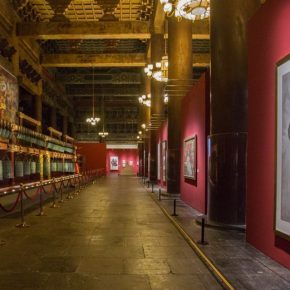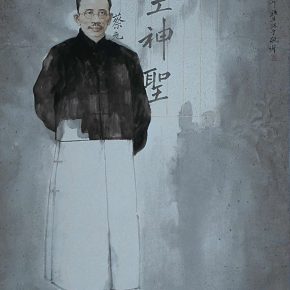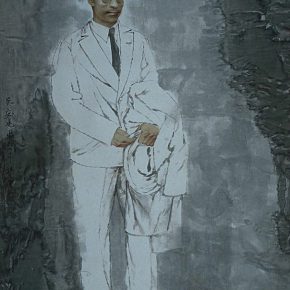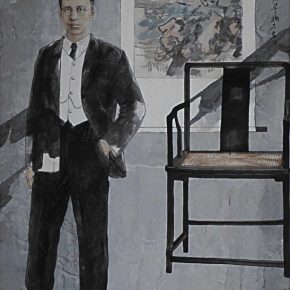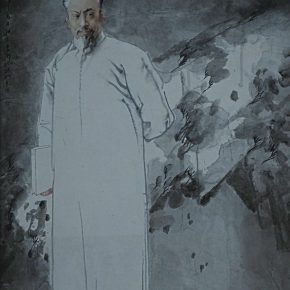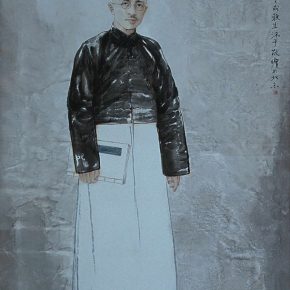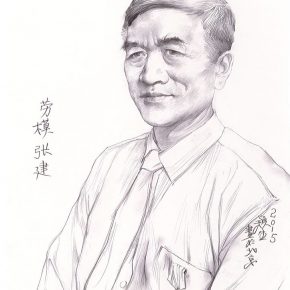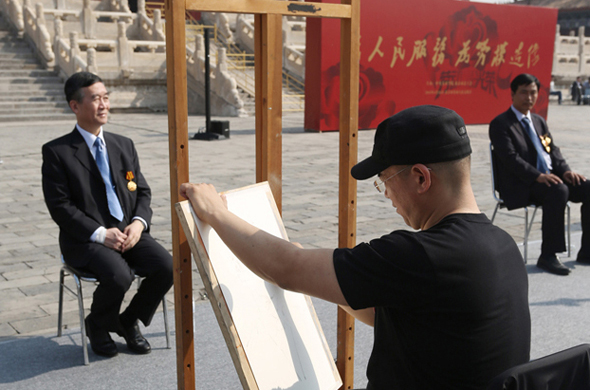
“Portraits of the Times” which is also the third part of the series of exhibitions of “Echo of Civilization” opened at the Imperial Ancestral Temple. In this exhibition, Wang Yingsheng exhibited his “University Series” as an artist. This series of work focuses on a batch of educational masters and sages and thus forms the knowledge of an era; as a mode of creation, the creation of portraits of historical figures is very different from “Creating Portraits of Model Workers” in which he has participated. During the period of the exhibition of “Portraits of the Times”, Wang Yingsheng was interviewed by CAFA ART INFO, and talked about the two different modes of the creation of portraits which explained how he refined the image of a great scholar from the Republic of China for the “University Series” in his creative process in detail and also started his creative experiences in talking about the contemporary issues of portraits and the portraits of Chinese painting.
Date: January 19, 2018
Venue: The Central Academy of Fine Arts
Interviewer and copywriter: Zhang Wenzhi – CAFA ART INFO
Interviewee: Wang Yingsheng (hereinafter referred to as “Wang”)
Translated by Chen Peihua and edited by Sue/CAFA ART INFO
CAFA ART INFO: In the exhibition of “Portraits of the Times” presents the work of “Cai Yuanpei”, which is one piece of the “University Series”. The portraits of the sages and intellectuals are also subjects of traditional Chinese painting. It is composed of the portraits of “sages”, embodying the Confucian culture and intellect and “Pictures of Past-Masters”, embodying the interest of “seclusion”. When you create this series of works, what is your attitude toward this series of characters and themes?
Wang: The “University Series” was created at the invitation of a cultural and educational center at Tsinghua University, and all the works are devoted to the great scholars and professors who have devoted their life and all things in the field of education in China. It features the work of “Cai Yuanpei” created in 2002. When I looked at them, I thought they represented an era, representing an academic direction, their character and thought illuminated both themselves, and the descendants. Perhaps this attitude has inspired me to finish the painting. Therefore, when I see the object, I have an attitude that neither presents the literati of traditional painting, nor presents the feelings of a hermit but highlights the presentation of thought and knowledge of this person and through this person is able to show the cultural spirit at that time.
CAFA ART INFO: Although we have not seen a character in this series, or this type of creation, all Chinese people, including you and me, are familiar with the image, which has been formed through our education and reading. How do you deal with the relationship between the image in the painting and the established image in your mind when you are creating? How is your creative image refined?
Wang: It should be said that everyone has an excepted image of the character in his mind as a benchmark for us being a man, working, and learning. In fact, it is a process of sublimation that starts from studying the person at the beginning to the composition of a painting. Maybe this figure will coincide with the cognition of people’s minds, but if I find a perspective that is different from others’, I will not hesitate to use it. The whole process of the refining of the image, will take others’ cognition of the image into account, but it is only part of the factors while I mainly present my personal understanding of this figure.
Take the portrait of “Hu Shi” and the portrait of “Cai Yuanpei” in this series as an example, it is hard to clearly see the whole-body image in the documents. In fact, I also looked for photos of figures during the Period of the Republic of China, referring to their costumes and combining them together to create an image, which has never appeared in history. Therefore, this figure is like the integrated image of the intellectuals during the Period of the Republic of China.
CAFA ART INFO: I have also seen some other works, such as sketches that have been finished for “Creating Portraits of Model Workers”, which are two different modes of creation, including simply extracting an image from documents in the reading, and drawing a person who is sitting in front of you, like “Creating Portraits of Model Workers”. Please talk about the two different modes of portrait creation.
Wang: “Creating Portraits of Model Workers” is a sketch, emphasizing the sense of presence and this person is sitting opposite me. Perhaps I have never seen the person and have never studied him, and I can only get the understanding of the image through a short exchange and contact. “University Series” is a distant memory, I see a person from far away, which is a review of a period of history, with a difference in time and space. One piece is face-to-face observation, while the other piece is a distant tribute to that generation, an observation and manifestation of distant memories.
CAFA ART INFO: The theme of this exhibition is “Portrait of the Times”, and you are also a participant of the planning of the exhibition. How do you understand the theme of this exhibition? How should we understand the sense of the contemporary of the portraits?
Wang: This exhibition was called “China’s Faces” and “Portraits of China” during the period of planning, and it was later renamed “Portraits of the Times”. It has the characteristics of each era. For example, through Wu Zuoren we can see the face of the Republic of China. And later, there were some specific features of this period in the 1950s and 1960s, and it then formed some documents. It has a specific figure, a specific scene, a special experience in each era, and perhaps one image represents one era. The exhibition also spans a long time, including the portraits of contemporary model workers, through the exhibition we can see people of different times, from different environments and different strata, who represent different times.
CAFA ART INFO: You have started from the image to expatiate the sense of the contemporary of the portraits, and then how to look at the sense of the contemporary from the perspective of language and methods of artistic expression? Pleas combine your own creative experience in talking about it.
Wang: It is a truth. For example, the early oil paintings in China were still at a naive stage, so they tried their best to learn from Europe and presented tendencies that were similar with the Nordic countries or France and Italy. Later, the local oil paintings appeared in China in the 1950s, and the painters groped with the own laws in the shaping of oil painting by themselves because they had never gone out to other places. It is certain that it is a particularly diversified state now, super realistic and expressive, and there was a great change in the understanding of materials. There are the laws revealed in the exhibition, and you can declare the times of a piece when you look at the technique and language of a work as well as it being a portrait of the times. In terms of Chinese ink paintings, it used ink and wash to perform a portrait in the past, for example, portraits were meticulously portrayed in the Ming and Qing Dynasties, and Chinese painting has a great ability to create the object. When I used the ink to express my own objects, I practically combined the painting methods of color, watercolor and drawing. Combining these with the Chinese painting material, I can meticulously portrait a portrait.
CAFA ART INFO: You are a teacher from the Department of Mural Painting, CAFA, and in items of figure portraits, mural painting should be an earlier manifestation and carrier of portraits, please simply talk about the earliest state of Chinese portraits and the status in the field of mural painting.
Wang: In the Han Dynasty, I would like to take the rewarding of people according to their contributions as an example, a person’s portrait and image was drawn on a high platform and his achievements were drawn on a high building, where people could go to visit, and it was like a window for the country to respect the merits of these people. As early as Qu Yuan’s “Tianwen (Inquiries of Heaven)”, it contained many such records, such as the portraits in the temple. Therefore, Chinese portraits appeared very early on, with a strong functional and ceremonial nature. Later, it drew portraits in some tomb murals, showing the great achievements of the tomb owner’s life.
Portrait is also an important theme of mural creation and mural painting is promising at present, because the development of infrastructure in China and the urban development have brought many opportunities for mural painting. However, a mural project requires to be finished quickly and many projects are invited to create, which brings great difficulties to the artistic creation though it is easy to be produced in a rough way. There is also hope that the mural painters cherish the opportunity of the times and truly exert their talents.


